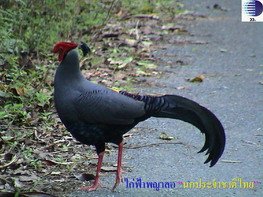
SERS AND THE MAB BIOSPHERE RESERVE
SERS is part of an international network of biosphere reserves and one of four such reserves in Thailand . As of 2001, there were 411 reserves in 94 countries. This is known as the World Network of Biosphere Reserves and is promoted by UNESCO through its Man and Biosphere (MAB) programme.
The broad aim of the MAB programme is to develop a basis for improving the global relationship between people and the environment. It promotes interdisciplinary research and training in ecosystem conservation, and the rational use of natural resources. At its first meeting in 1971, the MAB Council recognized that efforts to establish an adequate network of protected areas had so far met with disappointing results on the global scale. They regarded reserved areas as being of fundamental importance to the MAB programme since they represent baselines or standards against which change can be measured and the performance of other ecosystems judged. They therefore proposed a project that would assist governments to select, set aside and to manage areas that would be designated ‘Biosphere Reserves'. Today, these reserves constitute a world-wide network of protected areas of land and coastal environments. Importantly, the network includes significant examples of the world's major ecosystem types: mountains, tropical and temperate forests, wetlands, arid and semi-arid lands, coastal zones and islands.
The biosphere reserves link ecology with economics, sociology and politics. The aim of a reserve is to maximize the conservation of an area's natural environment and biodiversity while managing people's use of it resources for sustainable socio-economic development. The reserves look to promote solutions that reconcile the conservation of biodiversity with its sustainable use. The management of a biosphere reserves brings together government departments and local people who may depend on the reserve for their livelihood.
The MAB Council set the three primary objectives of the biosphere reserves. Today, these are interpreted as:
- A conservation function: the reserve contributes to the conservation of landscapes, ecosystems, species and genetic variation.
- A development function: the reserve fosters economic development which is ecologically and culturally sustainable.
- A logistic support function: the reserve serves as a research site and provides support for research, education, training and monitoring.
The Council emphasized that conservation is the highest priority in the purpose and use of the biosphere reserves. Where this does not conflict, the objective of research has developed so that the principle function at many sites is providing a logistical base for long-term ecological research.
Biosphere reserves are organized into three inter-related zones. This allows for clear demarcation of the different uses of the reserve. The core area exists for the long-term protection of biodiversity. This is surrounded by a buffer zone, used for recreation, education, research and sustainable resource use when this is compatible with the ecosystem conservation objectives. It also serves as a shield to protect the core from the direct impact of human activities. Outside the buffer is the transitional zone, used for agriculture and other rural activities, including human settlements.
SERS and the area around the station was declared the Sakaerat Biosphere Reserve in 1977. The Sakaerat Biosphere Reserve is the largest of Thailand 's four biosphere reserves and the most active. The core area of the biosphere reserve and some parts of the buffer region are included in the boundaries of the SERS station. The core area is 58km ² and consists of natural, primary forest, some areas of natural regeneration and the SERS headquarters. The buffer zone is 92km ² . It contains all areas of reforestation. The largest area is the transitional zone, 673km ² . Approximately 72,000 people in 159 villages live in this zone, and 84% of the households work in agriculture.
SERS is responsible for the management of the biosphere reserve. The management and activities of SERS matches the three functions the MAB programme has for biosphere reserves.
- Conservation: under Thai law it is illegal to hunt animals or harvest mushrooms and plants on the station, and therefore also in the core zone. SERS enforces this ban by employing a number of rangers who patrol against illegal activities. It also brings evidence in legal cases against poachers who are caught.
- Economic development: the SERS edible plant seedling distribution and mushroom farm programmes (see information under heading “SERS History”) contribute to sustainable agricultural practices in the area. There are also financial benefits to the villages economy derived from the eco-tourism at SERS.
- Logistical research support: SERS has a long history as a site for tropical scientific research and training. It has accommodation and laboratory facilities for researchers, as well as a popular site for biology student field-trips for training in biological and ecology studies. The station also hosts a number of school-group science camps to teach children about the forest and conservation.
The Huay Tak Biosphere Reserve in Lamphang province and the Kog Ma-Mae Sa in Chiang-Mai province were established two years after the Sakaerat reserve. Huay Tak reserve contains the oldest teak plantations in Thailand and there are various teak research projects being conducted in the reserve. The Ranong Biosphere Reserve is the most recent reserve in Thailand , established in 1997. It is on the Andaman Coast on the Thai Peninsula . Mangrove forests largely cover this reserve and the reserve is being used for a number of Thai and international mangrove ecology research projects. All reserves have a core area, surrounded by a buffer and a transitional zone.

::::::Sakaerat Environmental Research Station:::::